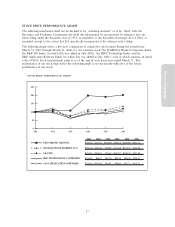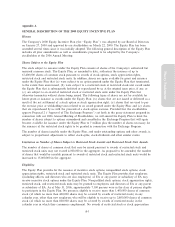Electronic Arts 2006 Annual Report Download - page 47
Download and view the complete annual report
Please find page 47 of the 2006 Electronic Arts annual report below. You can navigate through the pages in the report by either clicking on the pages listed below, or by using the keyword search tool below to find specific information within the annual report.
executive's cash compensation should be performance-based and ""at risk'' Ì varying from year to year
depending on EA's Ñnancial and operational performance and on the individual meeting Ñnancial and other
performance measures. Consistent with this philosophy, and in light of the Company's Ñnancial
performance during Ñscal 2006, several of EA's most senior executive oÇcers, including the Chief
Executive OÇcer, all Executive Vice Presidents, and the CEO's other executive direct reports, did not
receive an incentive bonus for the second consecutive year. The Compensation Committee and the
Company remain committed to this ""pay-for-performance'' philosophy which ensures that executive
compensation will reÖect the Company's and the executive's performance.
As the employment market has improved over the last Ñscal year, EA has experienced competitive
recruiting eÅorts aimed at its executives. EA's leading position within the entertainment industry makes it
a prime target for recruiting of executives and key creative talent.
The Company also continues to recruit for key talent and executives. Competition in attracting and
retaining talent comes primarily from three broad industry segments: entertainment, high technology and
consumer packaged goods. EA has continued to build its senior management team and has been successful
in attracting talent from the entertainment software industry and other market segments to add
management depth and experience to the organization. The Company continues to look at creative new
methods using its compensation programs to successfully recruit new talent into the organization while
maintaining parity with compensation of current key executives. Just as important as recruiting new talent
and executives into the organization, is the internal development and retention of key talent and
executives. As EA grows, it will, like all organizations, have normal turnover within its executive ranks.
Data Considered and Process Used
Proxy Statement
In Ñscal 2006, at the direction of the Compensation Committee, EA's Human Resources department
gathered executive compensation data from nationally recognized surveys and provided a comprehensive
analysis of this data to the Compensation Committee and its independent compensation consulting Ñrm.
The factors used to determine the participants in the survey included industry type, annual revenues,
industry growth rate and geography. Companies included in this data were from high technology (primarily
software developers), entertainment and selected packaged goods companies as reference points. The
companies in the compensation survey overlap considerably with the companies contained in the RDG
Technology Composite index. Additional companies included in the survey group were judged to be
relevant because they compete for executive talent with EA.
EA's executive level positions, including the CEO, were matched to comparable survey positions and
competitive market compensation levels to determine base salary ranges, target incentives and target total
cash compensation. EA's Human Resources department participated in comprehensive surveys such as the
Buck Global Long-Term Incentive Practices Survey and the Radford High Tech Executive Compensation
Survey to assist in determining appropriate equity compensation levels. This competitive market data was
reviewed by the Human Resources department with the CEO for each benchmark executive-level position,
and with the Compensation Committee for the CEO and other key executives. The Compensation
Committee also considers each executive's responsibility level and EA's Ñscal year performance compared
to objectives and potential performance targets for the subsequent year.
Executive Compensation
The Compensation Committee awards executive compensation in three components: base salary, cash
incentive bonus and equity incentives. The Compensation Committee reviews and, if appropriate, adjusts
executive base salary and equity compensation each February, and reviews executive bonus recommenda-
tions and approves bonus payments each May.
Base Salary. In reviewing executive base salaries, the Compensation Committee considered each
executive's performance over the last year as reported by the CEO and the Head of Human Resources,
each executive's responsibility level, and the third quartile (50th to 75th percentile) of base salaries
reported in the competitive market compensation surveys noted above. In Ñscal 2006, those eligible
35
























